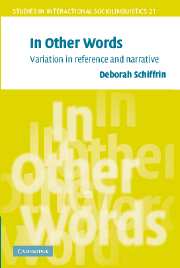Book contents
- Frontmatter
- Contents
- List of figures
- List of tables
- Preface
- 1 Variation
- 2 Problematic referrals
- 3 Anticipating referrals
- 4 Reactive and proactive prototypes
- 5 Referring sequences
- 6 Reframing experience
- 7 Retelling a story
- 8 Who did what (again)?
- 9 Redoing and replaying
- Appendix 1 Transcription conventions for data excerpts
- Appendix 2 Four versions of Susan Beer's capture story
- Appendix 3 Jack Cohen's narrative about Joey Bishop's childhood prank
- References
- Index
4 - Reactive and proactive prototypes
Published online by Cambridge University Press: 14 January 2010
- Frontmatter
- Contents
- List of figures
- List of tables
- Preface
- 1 Variation
- 2 Problematic referrals
- 3 Anticipating referrals
- 4 Reactive and proactive prototypes
- 5 Referring sequences
- 6 Reframing experience
- 7 Retelling a story
- 8 Who did what (again)?
- 9 Redoing and replaying
- Appendix 1 Transcription conventions for data excerpts
- Appendix 2 Four versions of Susan Beer's capture story
- Appendix 3 Jack Cohen's narrative about Joey Bishop's childhood prank
- References
- Index
Summary
Introduction
The process of referring to an entity about which we want to say something can be derailed by a variety of problems that can be remedied by a variety of solutions. In Chapter 2 on problematic referrals, we analyzed repairs in which referent and/or referring terms continued and/or were abandoned. We saw that speakers could interrupt and restart a noun phrase (e.g. in type 1 repairs, we- we), substitute one noun phrase for another (e.g. in type 2 repairs, we→they), or replace an incipient noun phrase with a descriptive clause (e.g. in type 3 repairs a- I wouldn't say he speaks German). In Chapter 3, repairs of cut-off switched articles (the→all of the, a→the) revealed different word-to-world connections; repairs of cut-off repeated articles (a- a, the- the) revealed lexical and/or conceptual uncertainty despite stable assumptions of hearer familiarity with an upcoming referent and felicitous placement in sentence and text.
The problematic referrals analyzed in this chapter differ in both problem and solution. The problem is the failure of the familiarity assumption: the speaker begins a referral by assuming a level of familiarity that then appears to be unwarranted. The solution draws together syntactic, semantic and discursive features as a single pragmatic prototype that can both remedy and pre-empt familiarity problems. Chapters 2 and 3 previewed important pieces of this solution: abandoning nominals for descriptive clauses; the sentence-initial presentation of familiar ‘light’ information and the sentence-final presentation of less familiar ‘heavy’ information.
- Type
- Chapter
- Information
- In Other WordsVariation in Reference and Narrative, pp. 110 - 153Publisher: Cambridge University PressPrint publication year: 2006



